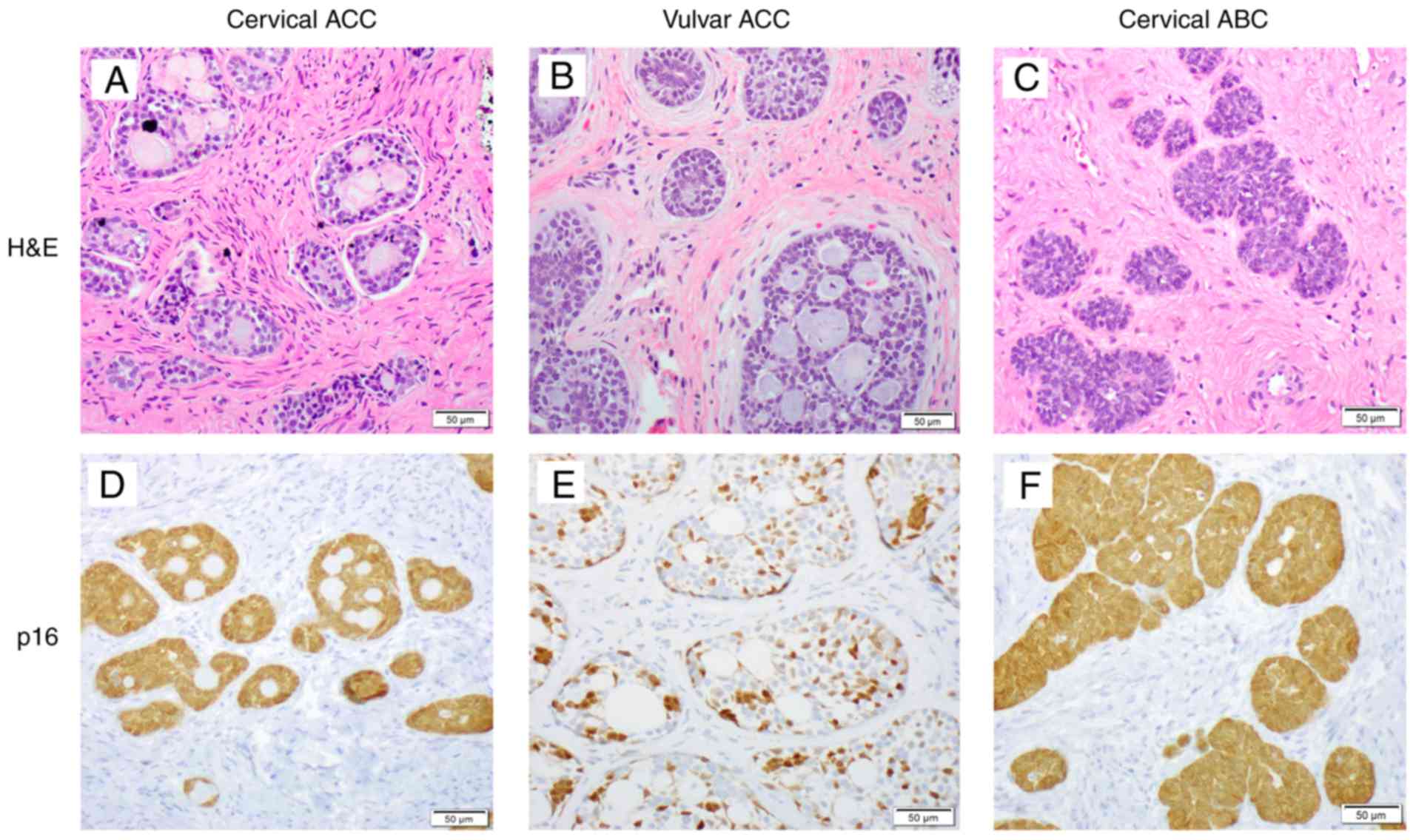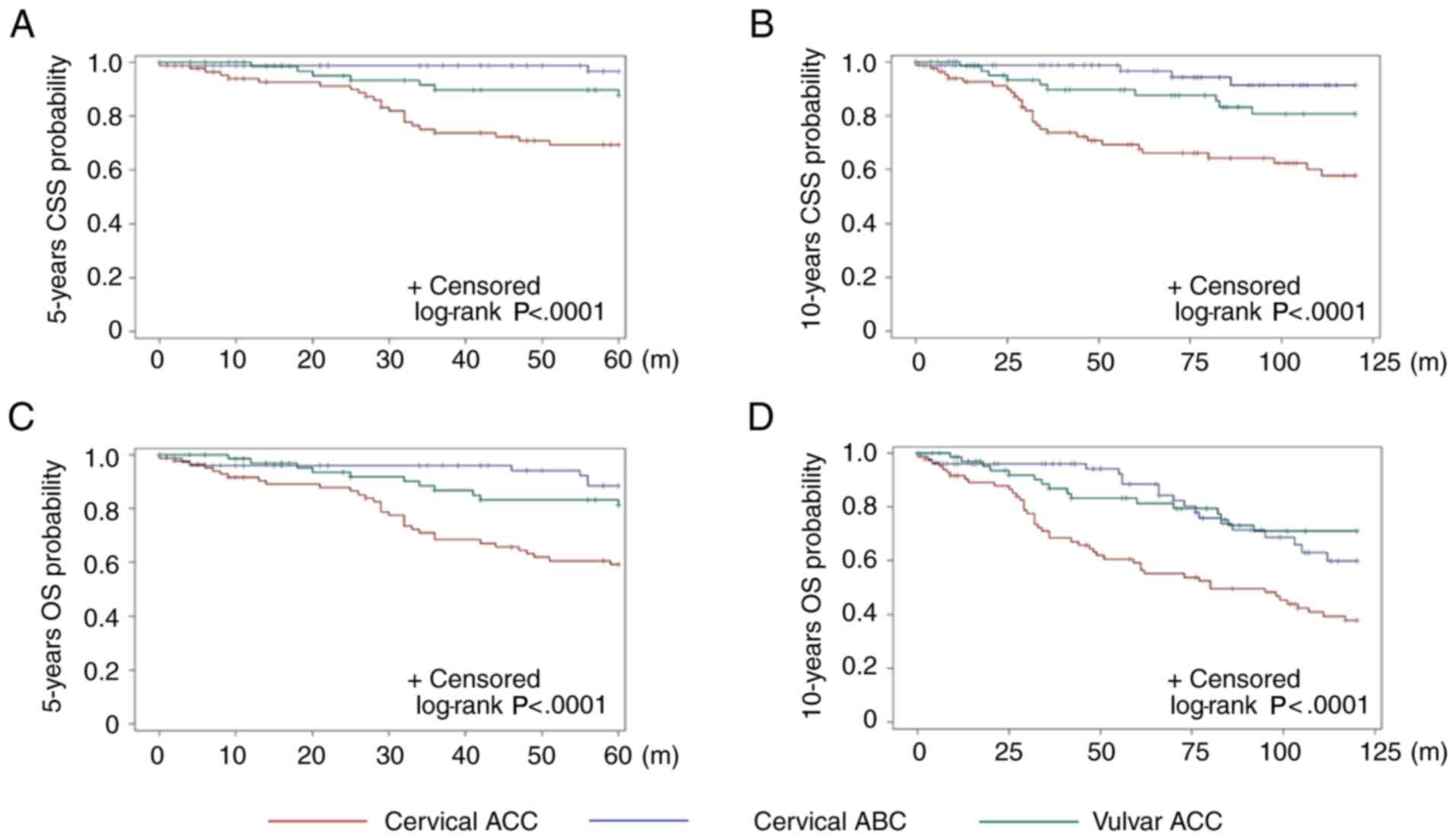|
1
|
Khan AJ, DiGiovanna MP, Ross DA, Sasaki
CT, Carter D, Son YH and Haffty BG: Adenoid cystic carcinoma: A
retrospective clinical review. Int J Cancer. 96:149–158. 2001.
View Article : Google Scholar : PubMed/NCBI
|
|
2
|
Ellington CL, Goodman M, Kono SA, Grist W,
Wadsworth T, Chen AY, Owonikoko T, Ramalingam S, Shin DM, Khuri FR,
et al: Adenoid cystic carcinoma of the head and neck: Incidence and
survival trends based on 1973–2007 surveillance, epidemiology, and
end results data. Cancer. 118:4444–4451. 2012. View Article : Google Scholar : PubMed/NCBI
|
|
3
|
van Weert S, Bloemena E, van der Waal I,
de Bree R, Rietveld DH, Kuik JD and Leemans CR: Adenoid cystic
carcinoma of the head and neck: A single-center analysis of 105
consecutive cases over a 30-year period. Oral Oncol. 49:824–829.
2013. View Article : Google Scholar : PubMed/NCBI
|
|
4
|
Iseli TA, Karnell LH, Graham SM, Funk GF,
Buatti JM, Gupta AK, Robinson RA and Hoffman HT: Role of
radiotherapy in adenoid cystic carcinoma of the head and neck. J
Laryngol Otol. 123:1137–1144. 2009. View Article : Google Scholar : PubMed/NCBI
|
|
5
|
Lloyd S, Yu JB, Wilson LD and Decker RH:
Determinants and patterns of survival in adenoid cystic carcinoma
of the head and neck, including an analysis of adjuvant radiation
therapy. Am J Clin Oncol. 34:76–81. 2011. View Article : Google Scholar : PubMed/NCBI
|
|
6
|
Jang S, Patel PN, Kimple RJ and McCulloch
TM: Clinical outcomes and prognostic factors of adenoid cystic
carcinoma of the head and neck. Anticancer Res. 37:3045–3052.
2017.PubMed/NCBI
|
|
7
|
Li N, Xu L, Zhao H, El-Naggar AK and
Sturgis EM: A comparison of the demographics, clinical features,
and survival of patients with adenoid cystic carcinoma of major and
minor salivary glands versus less common sites within the
surveillance, epidemiology, and end results registry. Cancer.
118:3945–3953. 2012. View Article : Google Scholar : PubMed/NCBI
|
|
8
|
Silverman DA, Carlson TP, Khuntia D,
Bergstrom RT, Saxton J and Esclamado RM: Role for postoperative
radiation therapy in adenoid cystic carcinoma of the head and neck.
Laryngoscope. 114:1194–1199. 2004. View Article : Google Scholar : PubMed/NCBI
|
|
9
|
Coca-Pelaz A, Rodrigo JP, Bradley PJ,
Vander Poorten V, Triantafyllou A, Hunt JL, Strojan P, Rinaldo A,
Haigentz M Jr, Takes RP, et al: Adenoid cystic carcinoma of the
head and neck-An update. Oral Oncol. 51:652–661. 2015. View Article : Google Scholar : PubMed/NCBI
|
|
10
|
Kurman RJ, Carcangiu ML, Herrington CS and
Young RH: WHO Classification of Tumors of Female Reproductive
Organs. 6. 4th. IARC Press; Lyon: 2014
|
|
11
|
Grayson W, Taylor LF and Cooper K: Adenoid
cystic and adenoid basal carcinoma of the uterine cervix:
Comparative morphologic, mucin, and immunohistochemical profile of
two rare neoplasms of putative ‘reserve cell’ origin. Am J Surg
Pathol. 23:448–458. 1999. View Article : Google Scholar : PubMed/NCBI
|
|
12
|
Xing D, Schoolmeester JK, Ren Z, Isacson C
and Ronnett BM: Lower female genital tract tumors with adenoid
cystic differentiation: P16 expression and high-risk HPV detection.
Am J Surg Pathol. 40:529–536. 2016. View Article : Google Scholar : PubMed/NCBI
|
|
13
|
Xing D, Bakhsh S, Melnyk N, Isacson C, Ho
J, Huntsman DG, Gilks CB, Ronnett BM and Horlings HM: Frequent
NFIB-associated gene rearrangement in adenoid cystic carcinoma of
the vulva. Int J Gynecol Pathol. 36:289–293. 2017. View Article : Google Scholar : PubMed/NCBI
|
|
14
|
Jones MW, Kounelis S, Papadaki H, Bakker
A, Swalsky PA and Finkelstein SD: The origin and molecular
characterization of adenoid basal carcinoma of the uterine cervix.
Int J Gynecol Pathol. 16:301–306. 1997. View Article : Google Scholar : PubMed/NCBI
|
|
15
|
Grayson W, Taylor LF and Cooper K: Adenoid
basal carcinoma of the uterine cervix: Detection of integrated
human papillomavirus in a rare tumor of putative ‘reserve cell’
origin. Int J Gynecol Pathol. 16:307–312. 1997. View Article : Google Scholar : PubMed/NCBI
|
|
16
|
Parwani AV, Smith Sehdev AE, Kurman RJ and
Ronnett BM: Cervical adenoid basal tumors comprised of adenoid
basal epithelioma associated with various types of invasive
carcinoma: Clinicopathologic features, human papillomavirus DNA
detection, and P16 expression. Human pathology. 36:82–90. 2005.
View Article : Google Scholar : PubMed/NCBI
|
|
17
|
Grayson W and Cooper K: Adenoid basal
epithelioma versus adenoid basal carcinoma. Am J Surg Pathol.
24:313–314. 2000. View Article : Google Scholar : PubMed/NCBI
|
|
18
|
National Cancer Institute Surveillance E,
and End Results (SEER) Program (www.seer.cancer.gov) SEER*Stat
Database: Incidence-SEER 9 Regs Research Data, Nov 2016 Sub
(1973–2014) <Katrina/Rita Population Adjustment> - Linked To
County Attributes-Total U.S., 1969–2015 Counties, National Cancer
Institute DCCPS, Surveillance Research Program, released April
2017, based on the November 2016 submission. https://seer.cancer.gov/data-software/documentation/seerstat/nov2016/November
18–2016
|
|
19
|
Ferry JA and Scully RE: ‘Adenoid cystic’
carcinoma and adenoid basal carcinoma of the uterine cervix. A
study of 28 cases. Am J Surg Pathol. 12:134–144. 1988. View Article : Google Scholar : PubMed/NCBI
|
|
20
|
Small W Jr, Bacon MA, Bajaj A, Chuang LT,
Fisher BJ, Harkenrider MM, Jhingran A, Kitchener HC, Mileshkin LR,
Viswanathan AN, et al: Cervical cancer: A global health crisis.
Cancer. 123:2404–2412. 2017. View Article : Google Scholar : PubMed/NCBI
|
|
21
|
Zhou J, Wu SG, Sun JY, Li FY, Lin HX, Chen
QH and He ZY: Comparison of clinical outcomes of squamous cell
carcinoma, adenocarcinoma, and adenosquamous carcinoma of the
uterine cervix after definitive radiotherapy: A population-based
analysis. J Cancer Res Clin Oncol. 143:115–122. 2017. View Article : Google Scholar : PubMed/NCBI
|
|
22
|
Viens LJ, Henley SJ, Watson M, Markowitz
LE, Thomas CC, Thompson TD, Razzaghi H and Saraiya M: Human
papillomavirus-associated cancers-United States, 2008–2012. MMWR
Morb Mortal Wkly Rep. 65:661–666. 2016. View Article : Google Scholar : PubMed/NCBI
|
|
23
|
Brainard JA and Hart WR: Adenoid basal
epitheliomas of the uterine cervix: A reevaluation of distinctive
cervical basaloid lesions currently classified as adenoid basal
carcinoma and adenoid basal hyperplasia. Am J Surg Pathol.
22:965–975. 1998. View Article : Google Scholar : PubMed/NCBI
|
|
24
|
Russell MJ and Fadare O: Adenoid basal
lesions of the uterine cervix: Evolving terminology and
clinicopathological concepts. Diagn Pathol. 1:182006. View Article : Google Scholar : PubMed/NCBI
|
|
25
|
Albores-Saavedra J, Manivel C, Mora A,
Vuitch F, Milchgrub S and Gould E: The solid variant of adenoid
cystic carcinoma of the cervix. Int J Gynecol Pathol. 11:2–10.
1992. View Article : Google Scholar : PubMed/NCBI
|
|
26
|
van Dinh T and Woodruff JD: Adenoid cystic
and adenoid basal carcinomas of the cervix. Obstet Gynecol.
65:705–709. 1985.PubMed/NCBI
|
|
27
|
Chen TD, Chuang HC and Lee LY: Adenoid
basal carcinoma of the uterine cervix: Clinicopathologic features
of 12 cases with reference to CD117 expression. Int J Gynecol
Pathol. 31:25–32. 2012. View Article : Google Scholar : PubMed/NCBI
|
|
28
|
Dixit S, Singhal S, Vyas R, Murthy A and
Baboo HA: Adenoid cystic carcinoma of the cervix. J Postgrad Med.
39:211–215. 1993.PubMed/NCBI
|
|
29
|
Bjorndal K, Krogdahl A, Therkildsen MH,
Charabi B, Kristensen CA, Andersen E, Schytte S, Primdahl H,
Johansen J, Pedersen HB, et al: Salivary adenoid cystic carcinoma
in Denmark 1990–2005: Outcome and independent prognostic factors
including the benefit of radiotherapy. Results of the Danish Head
and Neck Cancer Group (DAHANCA). Oral Oncol. 51:1138–1142. 2015.
View Article : Google Scholar : PubMed/NCBI
|
|
30
|
Kaur P, Khurana A, Chauhan AK, Singh G,
Kataria SP and Singh S: Adenoid cystic carcinoma of cervix:
Treatment strategy. J Clin Diagn Res. 7:2596–2597. 2013.PubMed/NCBI
|
|
31
|
Prempree T, Villasanta U and Tang CK:
Management of adenoid cystic carcinoma of the uterine cervix
(cylindroma): Report of six cases and reappraisal of all cases
reported in the medical literature. Cancer. 46:1631–1635. 1980.
View Article : Google Scholar : PubMed/NCBI
|
|
32
|
Koyfman SA, Abidi A, Ravichandran P,
Higgins SA and Azodi M: Adenoid cystic carcinoma of the cervix.
Gynecol Oncol. 99:477–480. 2005. View Article : Google Scholar : PubMed/NCBI
|
|
33
|
Nishida M, Nasu K, Takai N, Miyakawa I and
Kashima K: Adenoid cystic carcinoma of the uterine cervix. Int J
Clin Oncol. 10:198–200. 2005. View Article : Google Scholar : PubMed/NCBI
|
|
34
|
King LA, Talledo OE, Gallup DG, Melhus O
and Otken LB: Adenoid cystic carcinoma of the cervix in women under
age 40. Gynecol Oncol. 32:26–30. 1989. View Article : Google Scholar : PubMed/NCBI
|
|
35
|
Phillips GL Jr and Frye LP: Adenoid cystic
carcinoma of the cervix: A case report with implications for
chemotherapeutic treatment. Gynecol Oncol. 22:260–262. 1985.
View Article : Google Scholar : PubMed/NCBI
|
|
36
|
Nomura H, Nagashima M, Aoki Y and
Takeshima N: Resection of the inferior pubic ramus to completely
remove locally advance adenoid cystic carcinoma of Bartholin's
gland. Gynecol Oncol. 147:723–724. 2017. View Article : Google Scholar : PubMed/NCBI
|
|
37
|
Woida FM and Ribeiro-Silva A: Adenoid
cystic carcinoma of the Bartholin gland: An overview. Arch Pathol
Lab Med. 131:796–798. 2007.PubMed/NCBI
|
|
38
|
Yoon G, Kim HS, Lee YY, Kim TJ, Choi CH,
Song SY, Kim BG, Bae DS and Lee JW: Analysis of clinical outcomes
of patients with adenoid cystic carcinoma of Bartholin glands. Int
J Clin Exp Pathol. 8:5688–5694. 2015.PubMed/NCBI
|
|
39
|
Mousa A, Rahimi K and Warkus T:
Neoadjuvant chemoradiotherapy followed by radical vulvectomy for
adenoid cystic carcinoma of Bartholin's gland: A case report and
review of the literature. Eur J Gynaecol Oncol. 37:113–116.
2016.PubMed/NCBI
|
|
40
|
Yang SY, Lee JW, Kim WS, Jung KL, Lee SJ,
Lee JH, Bae DS and Kim BG: Adenoid cystic carcinoma of the
Bartholin's gland: Report of two cases and review of the
literature. Gynecol Oncol. 100:422–425. 2006. View Article : Google Scholar : PubMed/NCBI
|
|
41
|
Ferry JA: Adenoid basal carcinoma of the
uterine cervix: Evolution of a distinctive clinicopathologic
entity. Int J Gynecol Pathol. 16:299–300. 1997. View Article : Google Scholar : PubMed/NCBI
|
|
42
|
Wincewicz A, Lewitowicz P, Urbaniak-Wasik
S, Kanczuga-Koda L, Koda M, Adamczyk-Gruszka O and Sulkowski S:
Adenoid basal carcinoma-like tumor combined with invasive squamous
cell carcinoma foci of uterine cervix-A case report of 55-year-old
woman with literature review. Rom J Morphol Embryol. 55 Suppl
3:S1225–S1230. 2014.
|
|
43
|
Teramoto N, Nishimura R, Saeki T, Nogawa T
and Hiura M: Adenoid basal carcinoma of the uterine cervix: Report
of two cases with reference to adenosquamous carcinoma. Pathology
international. 55:445–452. 2005. View Article : Google Scholar : PubMed/NCBI
|
|
44
|
Takeshima Y, Amatya VJ, Nakayori F, Nakano
T, Iwaoki Y, Daitoku K and Inai K: Co-existent carcinosarcoma and
adenoid basal carcinoma of the uterine cervix and correlation with
human papillomavirus infection. Int J Gynecol Pathol. 21:186–190.
2002. View Article : Google Scholar : PubMed/NCBI
|
|
45
|
Shi X, Wu S, Huo Z, Ling Q, Luo Y and
Liang Z: Co-existing of adenoid cystic carcinoma and invasive
squamous cell carcinoma of the uterine cervix: A report of 3 cases
with immunohistochemical study and evaluation of human
papillomavirus status. Diagn Pathol. 10:1452015. View Article : Google Scholar : PubMed/NCBI
|
|
46
|
Yannacou N, Gerolymatos A, Parissi-Mathiou
P, Chranioti S and Perdikis T: Carcinosarcoma of the uterine cervix
composed of an adenoid cystic carcinoma and an homologous stromal
sarcoma. A case report. Eur J Gynaecol Oncol. 21:292–294.
2000.PubMed/NCBI
|
|
47
|
Mathoulin-Portier MP, Penault-Llorca F,
Labit-Bouvier C, Charafe E, Martin F, Hassoun J and Jacquemier J:
Malignant mullerian mixed tumor of the uterine cervix with adenoid
cystic component. Int J Gynecol Pathol. 17:91–92. 1998. View Article : Google Scholar : PubMed/NCBI
|













